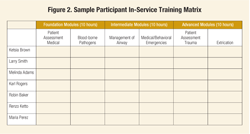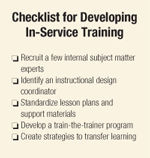The Public Manager Magazine Article
The In-Service Zone
Mandated training is often worn and ineffective. A prescriptive method can boost effectiveness, help with knowledge transfer, and standardize the approach without being boring.
Mon Dec 24 2012

You are about to enter another dimension, a dimension not only of sight and sound, but of mind. A journey into a land of imagination, a land of shadow and substance, of things and ideas. You've just crossed over into the In-Service Zone.
Does your in-service training sound like it comes from another dimension? Have you lived through endless hours of mandated training? To be sure, it's the special time in the special place known as the In-Service Zone. As you embark on the next in-service, you've succumbed to the misty region of the known, repeating topics; worn, yet necessary. And for what purpose?
For the Record
Witness if you will the many dimensions of government—from public safety to public service, from homecare to healthcare, from education to engineering, and from social services to civil services—for which in-service training is scheduled annually. Much is offered to the same staff, with the same content, delivered by the same instructors. For the record, you are not dreaming, you are participating in the In-Service Zone.
To avoid the redundant, one-size-fits-all approach of in-service training, consider a more prescriptive approach: target, analyze, develop, deliver, and evaluate (see Figure 1).
Target
Annual in-service training is typically mandated to enhance job proficiency, meet accreditation standards, reduce agency liability, and maintain employee credentials or certifications. How can your agency "target" your in-service training? More importantly, why target your in-service training?
The first step, target, involves defining the purpose of in-service, identifying the audience, and determining the expected results. Although often mandated, in-service training must go beyond the in-service zone to enhance job performance.
Begin by asking, "Why does our agency need in-service training?" Next ask, "How can our agency maximize the benefits of in-service training?" Educators, police and correctional officers, firefighters, paramedics, social workers, child protective investigators, healthcare workers, and many other professions achieve job proficiency through training, education, testing, and experience.
Maintaining and exceeding minimum job proficiency levels requires ongoing training, coaching, education, and testing. Ultimately, targeted in-service training coupled with informal learning opportunities should prepare public servants to better serve the public.
Analyze
The second step, analyze, includes an analysis of job tasks, individual performance, and work environment. Once you identify the purpose, audience, and results, in-service training designed to enhance job proficiency is best achieved by reviewing job descriptions, policies and procedures, best practices, and public feedback.
The goal in this step is to determine the proficiency levels of each in-service participant relevant to job requirements. Questions to ask might include: "How does Paramedic Perry perform an endotracheal intubation?" "Is Officer Olivia able to properly handcuff a suspect following standard operating procedures?" Creating a matrix or using a learning management system (LMS) to capture relevant job tasks and rating scales provides a snapshot of an individual's proficiency level.
In addition, benchmarking best practices and reviewing public feedback are ways to analyze job proficiency. According to Michael Marquardt, who has written extensively on organizational learning, "Best-practices benchmarking provides an organization with the rationale and process for accepting change as constant, inevitable, and beneficial."
Furthermore, Marquardt purports that "By their nature, best practices are dynamic and progressive." By analyzing public feedback from surveys, focus groups, and town hall meetings, agencies are better equipped to determine how individuals are meeting the needs of the public.
Develop
The third step, develop, includes writing the curriculum, designing a participant attendance matrix, and preparing instructors and managers. Developing agency policies and standard operating procedures standardizes the process. Curriculum is developed based on the analysis completed in step two.
What topics and learning objectives will be included? For each topic or training module, write content at defined proficiency levels—for example, at foundational, intermediate, and advanced levels. Important to developing content is engaging learners through action learning and practical skill-building exercises; make sure there's time for feedback and debriefs. Develop formative evaluations as part of the instructional process.
Knowledge-driven content can be developed as engaging learner-centered case studies, simulations, pre- and post-tests, and online learning modules. Job aids and user-friendly resource guides can supplement the in-service curriculum while supporting the transfer of knowledge and skills to the job. Foster inclusion and commitment to in-service training by recruiting internal subject matter experts (SMEs) to assist in developing content.
Consider developing a simple spreadsheet or participant in-service training matrix. As you see in Figure 2, the top row lists the in-service training modules for each proficiency level; the left column lists each employee.
Employees can self-select modules or managers can register employees based on the findings from step one, analyze. Ideally, using an automated LMS in which knowledge, skills, and abilities are defined as competencies for each job position allows for the selection of appropriate training modules based on a gap and match analyses.
Included in step three is preparing instructors and managers. Identify SMEs who are comfortable facilitating a learner-focused curriculum and who have excelled on the job. They are good candidates to develop and deliver in-service curriculum.
Also consider using a person trained in adult learning and instructional design who can guide the SMEs in content design. An instructional design coordinator can ensure continuity of themes and practices across modules by using a standard lesson plan format, templates, and other guides to capture content. Rosemary Caffarella's Planning Programs for Adult Learners: A Practical Guide for Educators, Trainers, and Staff Developers (2002) is an excellent resource for practitioners.
Finally, the develop step includes creating strategies to transfer learning to the workplace. By engaging managers and staff pre- and post- training, participants are better prepared to apply the knowledge and skills from the training to the job. Produce brief in-house videos of managers and staff attending classes, sharing testimonials, and participating in classroom exercises to promote interest. Design job aids, an online executive overview, action plans, or a brief, a "helpful tips" newsletter to supplement the in-service training.
Managers and staff can review these tools before and after in-service training. Consider using a Microsoft SharePoint portal to facilitate collaboration and manage content. The key is to develop brief, concise, and engaging pre- and post-training activities that help transfer learning. Think 60-second sound bites or content bites!
Deliver
The fourth step, deliver, involves conducting the in-service training. Whether you use SMEs or training staff to deliver in-service training, a parade of presenters can lead to disjointed delivery and a loss of continuity of themes. Instead, stay with a few dedicated instructors. Consider delivering a brief train-the-trainer program prior to in-service roll-out.
An in-service train-the-trainer program might include reviewing adult learning principles (David A. Kolb's experiential learning model and Learning Styles Inventory \[Robert W. Clark, Mark D. Threeton, and John C. Ewing, 2010\]); facilitating content while using support materials; and applying classroom management techniques. Preparing qualified in-service instructors to learn content, practice delivery, and facilitate discussions and exercises will build confidence and ensure consistency.
With proper planning and sufficient practice, delivering the actual in-service training modules should be effortless. Coordinating and publishing a schedule of in-service training modules will depend on the agency's procedures, often dictated by funding and staffing levels. Consider publishing a calendar of classes offering each level (foundation, intermediate, advanced) throughout the year. Use e-learning modules for knowledge-based instruction. If an agency does not have the resources to purchase and manage e-learning software and authoring tools, the second best approach is to develop and post engaging PowerPoint slides on the agency's internal website or SharePoint portal. Participants can review prior to or following a classroom module. Jane Bozarth's book Better Than Bullet Points: Creating Engaging E-Learning with PowerPoint is a wise investment for any agency.
Evaluate
The fifth step, evaluate, should be an ongoing process instead of an event, using both formative and summative approaches. Return to the purpose, audience, and expected results of in-service training. Evaluate job proficiency and assess public service satisfaction. All are critical to meeting and exceeding standards, reducing agency liability, and maintaining employee credentials or certifications.
The summative evaluation occurs at the end of the training, while the formative evaluation occurs throughout the training. Examples of summative evaluations might include tests, a final participant demonstration, observed change in knowledge or skill on the job, or customer satisfaction. Examples of formative evaluations might include quizzes, practice exercises, and intermittent skill-practice.
Two important considerations when applying evaluation approaches: assess the individual learner and provide descriptive feedback based on the expected criteria (or job-task competency). Communicating expectations, tracking performance, providing ongoing feedback, and evaluating results are the fabric of good management practice.
Out there... in the vastness of time, in the void that is learning, there is an enemy known as boredom. It sits there in the void waiting, forever waiting... in the In-Service Zone. For the record, you have just opened the door to your imagination.



You've Reached ATD Member-only Content
Become an ATD member to continue
Already a member?Sign In
